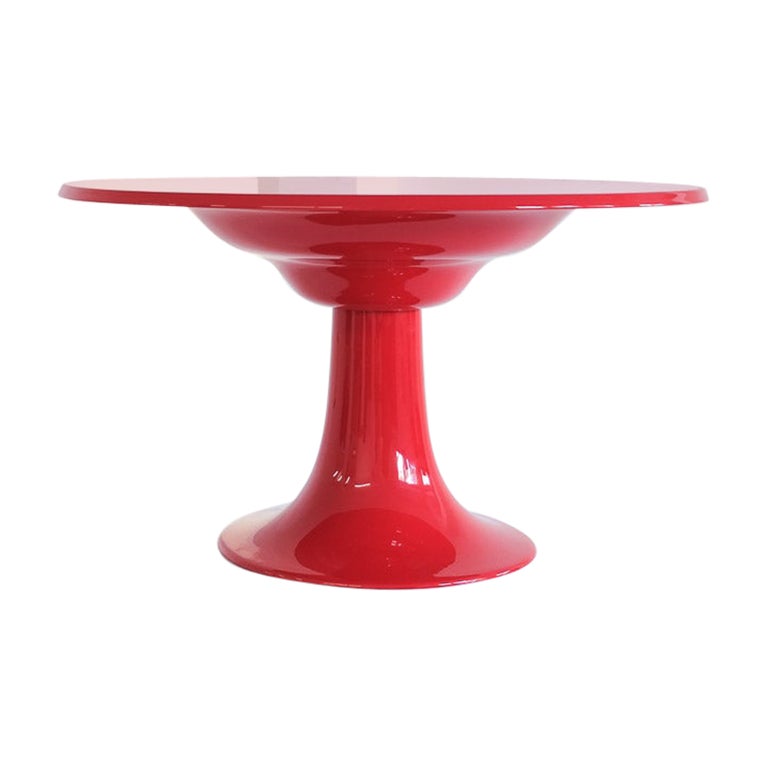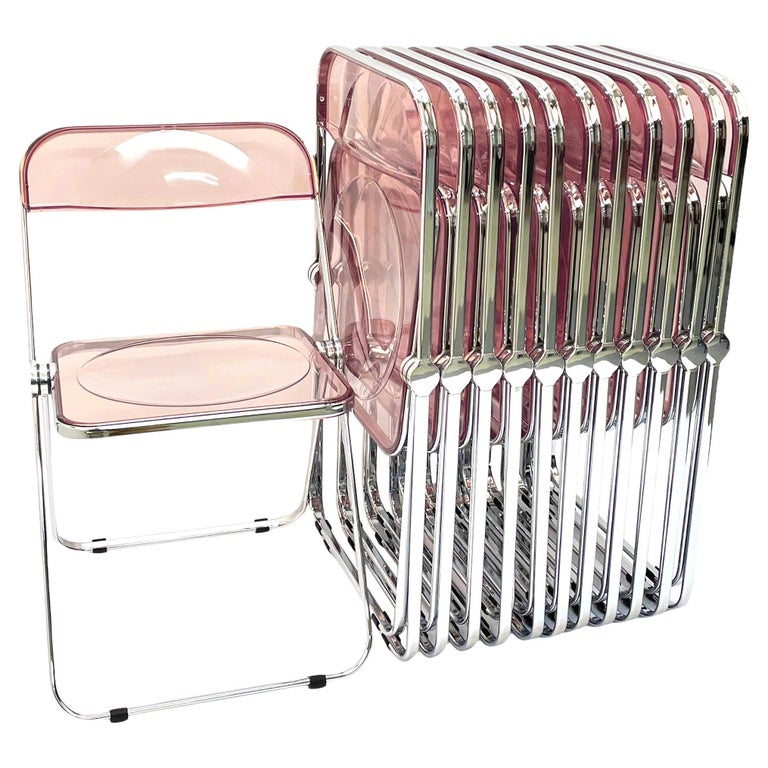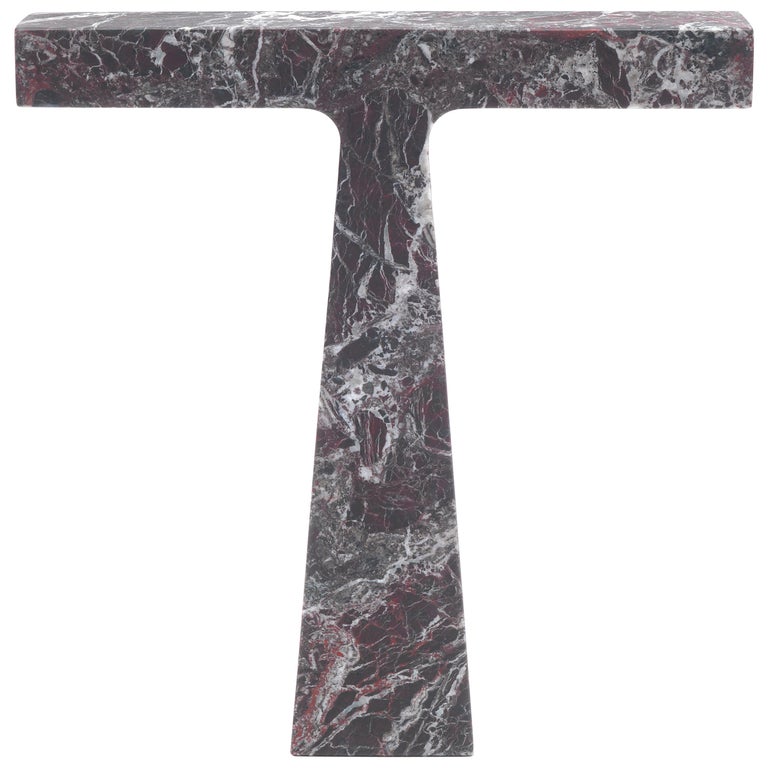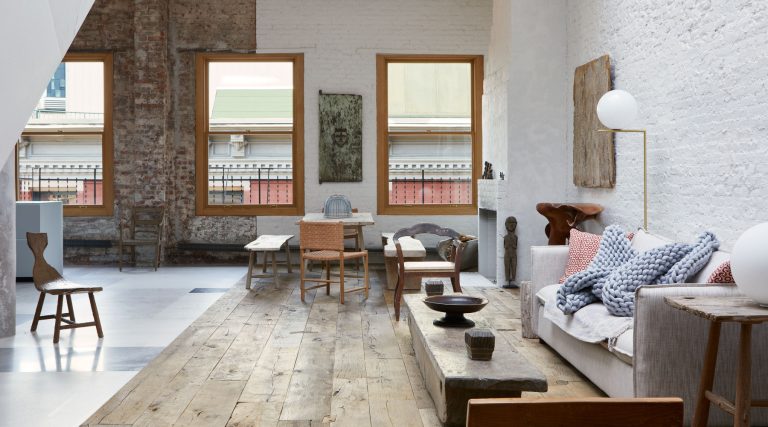June 9, 2024Spread out over the top two floors of a residential high-rise, this 6,250-square-foot apartment in the Achrafieh district of Beirut possesses two features that particularly attracted its future owner, Mohamed Maktabi, the first time he saw it. One was the roof terrace. The other, the sweeping views of not only the Mediterranean but also the Lebanese capital’s main mosque and Saint George Maronite Cathedral. “I have the city’s two major symbols clearly visible. So, I never forget where I am,” says Maktabi, cofounder of his family’s rug business, Iwan Maktabi.
Part of the brief he gave brother-and-sister designers Georges Maria and Michèle Chaya, of the Beirut- and London-based architectural firm MARIAGROUP, was to maximize those vistas. Floor-to-ceiling windows were installed, low-slung furniture favored to afford uninterrupted sight lines, and one wall in the large open living room painted gray. “The darker color helps to direct your gaze outside,” explains Maria.
There is only one space that doesn’t have a strong visual connection with the city — the primary bedroom. But that doesn’t really matter, says Maktabi: “I only go there to sleep. So, I have my eyes shut anyway.”

Another important criterion for him was to have a flowing open floor plan. A keen art collector, he wanted to be able to see his works from as many vantage points as possible. “My greatest pleasure is sitting in the morning, having my coffee and looking at all the beautiful objects,” he says.
Maktabi unabashedly describes his taste as eclectic. “Every purchase is spontaneous,” he explains. “I don’t follow a certain school. My motto is simple: If you like something, it’s never a mistake to buy it.” Among the dozens of works on show in the apartment are a series of paintings by New York– and Beirut-based artist Nabil Nahas inspired by the the sea, a Mark Rothko–esque abstract canvas by the late Lebanese artist Helen Khal and a George Condo line drawing.
The furnishings are equally diverse. On the first level of the apartment, they include, in the living room, an antique Damascene occasional table and a 1950s desk by Italian master Ico Parisi that divides the space in two. A sculptural armchair by the 20th-century French designer Philippe Hiquily enjoys the spotlight in the primary bedroom. Several other pieces scattered among the rooms on this level were created especially for the apartment by MARIAGROUP, such as the sleek Pentelic marble dining table.

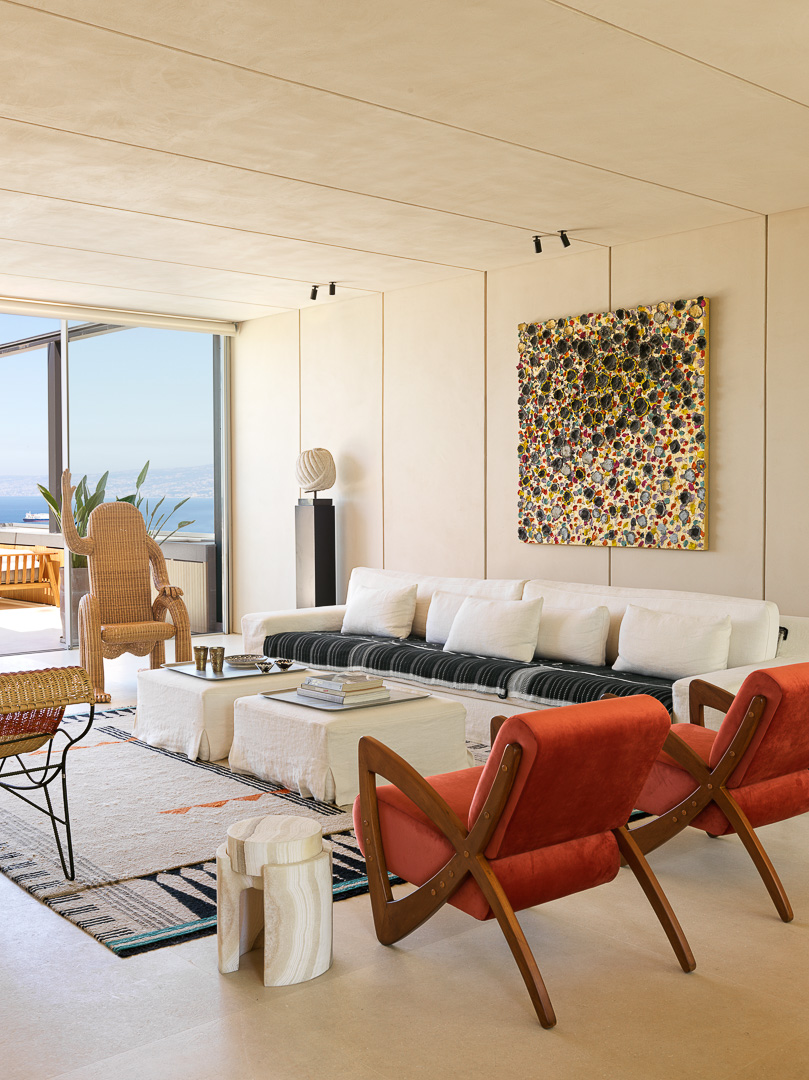
The upper floor, which centers on an airy sitting room, is deliberately more laid-back. “Mohamed wanted it to be like a travel experience, like a destination,” says Maria. The designers adopted a lighter palette, giving the walls and ceiling a rustic, traditional limewash. Placed with its back to the entrance to the roof terrace is an anthropomorphic chair designed by artist Chris Wolston that raises a jaunty arm in greeting.
The mood may be sunny today, but the project was not without adversity. By the time of the Beirut port explosion, in August 2020, the initial installation had more or less been completed. The damage to the architectural shell was extensive. Internal doors were ripped apart and windows blown into the apartment still attached to their frames. Yet miraculously, most of the artwork on the walls was spared.
The subsequent renovation is testimony to the success of the design and Maktabi’s love for it. “It could have been the opportunity for him to change things he didn’t like,” says Chaya. “Instead, we restored everything to exactly how it was.”
Here, a tour of what Maria and Chaya created.
ENTRANCE HALL

Visitors to the apartment are greeted by one of Los Angeles–based sculptor Thomas Houseago’s “Psychedelic Construction” masks. In front of it is a glazed-ceramic Japanese vase from the 1950s, standing on a vintage Ado Chale console table, while on the right-hand wall is a colorful canvas by the late Belgian artist Jo Delahaut. In the living room beyond, a painting of a king by José Lerma and a raku totem by Hala Matta stand watch over a chair made of natural fibers from Marni’s Zooteric furniture collection.
DINING AREA

In one part of the main living room, a bespoke Pentelic marble table created by MARIAGROUP is surrounded by a set of Afra and Tobia Scarpa’s Pigreco chairs, originally designed for Gavina in 1957 and reissued by Tacchini. Made from gun-metal-finished steel with oak shelves, the wall unit was conceived to be adjustable in order to house artworks and objects of different sizes over time. The orange Mark Rothko–style painting is by the late Lebanese artist Helen Khal, while the moody portrait of a young man is by Canadian painter Paul P.
LIVING ROOM
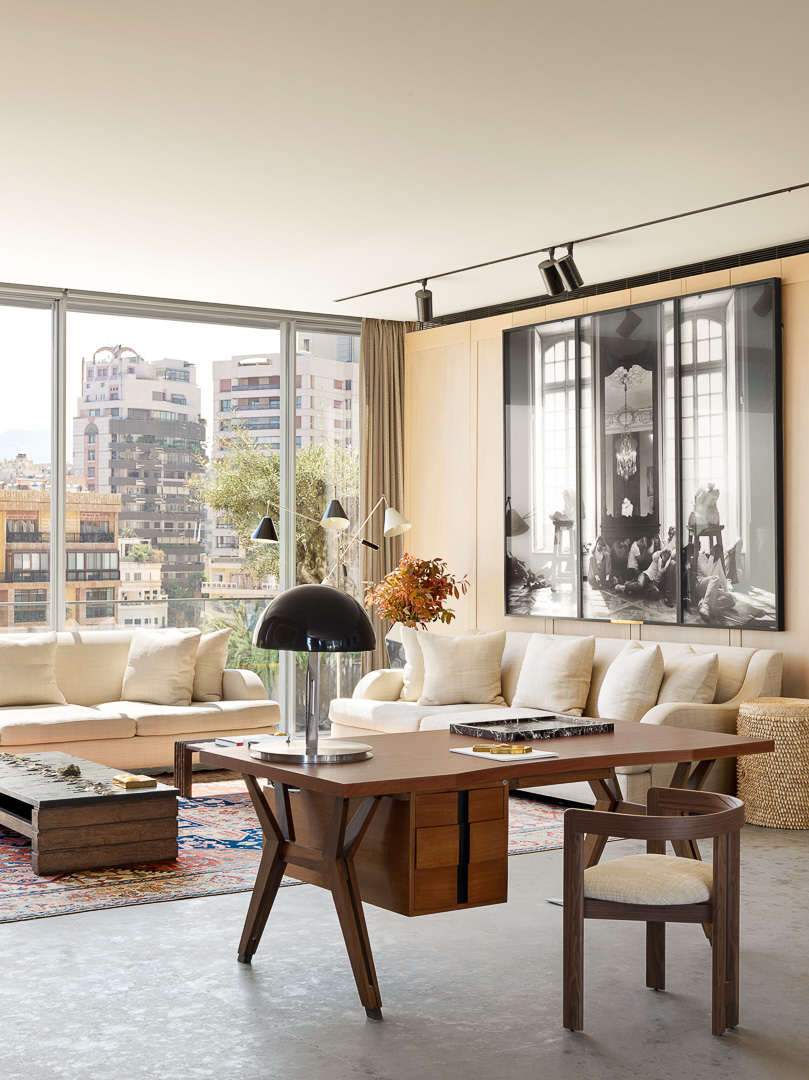
An Ico Parisi rosewood desk from 1958 acts as a divider between the two ends of this space. On top of it stands a Hiroshima lamp by Karen Chekerdjian. The black-and-white photo by Reza Aramesh provides a striking focal point in the seating area beyond. The two sofas were designed by May Daouk, the 19th-century rug is from northwest Persia, and the coffee tables, from the mid-1970s, are by Belgian designer Pia Manu. In the corner is an Angelo Lelli Triennale floor lamp, which gets its name from the Milan design fair at which it debuted in 1947.
KITCHEN

Centered on a stainless-steel island, the kitchen boasts a wall of windows for admiring the view. The range and ovens are from Wolf, while the stainless-steel hood was created especially by MARIAGROUP. A series of barstools from Komplot Design’s 3D collection for GUBI are grouped around the far end of the counter. The flooring is ceramic.
MAIN BEDROOM
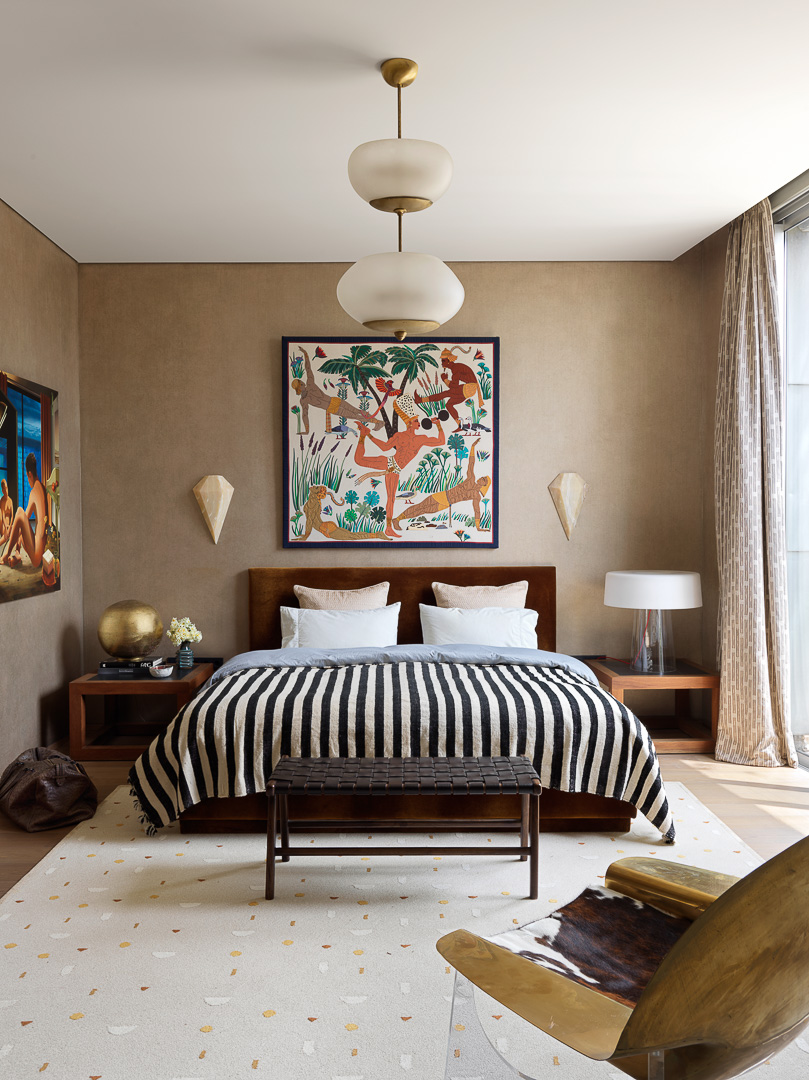
In the main bedroom, a vintage Coque armchair by Philippe Hiquily in hammered brass looks toward a painting by Kyle Dunn on the left-hand wall; behind the bed is a work by Louis Barthélemy created by applying textiles to a calico canvas using a traditional Egyptian technique called khayamiya. The striped blanket is from the Beirut homeware store Orient 499, the bedside lamp on the right is from Luc Ramael’s Glam collection for Prandina, and the rug is part of the Disoriented collection created by the local design duo David/Nicolas for Iwan Maktabi. The Murano glass and brass chandelier is a 1960s Seguso piece.
MAIN BATHROOM

The vertical planks of solid oak on the walls of the main bathroom echo the veins of the Striato Olimpico marble of the floor and custom vanity. Beyond the Vasco bathtub from Agape and to the right of the entrance to the dressing room, the designers placed a small work by Nabil Nahas and a marble jar made in Agra, India.
SITTING ROOM
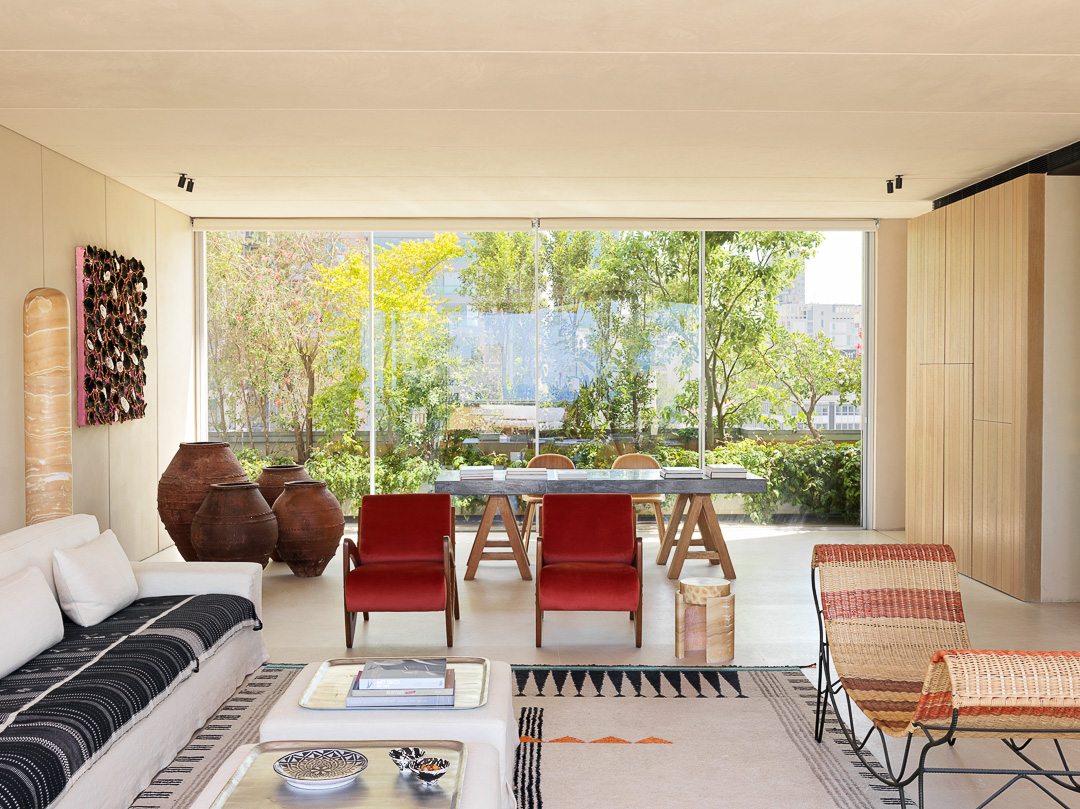
Located on the upper floor and connecting to the roof terrace, this secondary living room was conceived to be more relaxed in spirit. Bedecked with a striped blanket, the May Daouk–designed sofa faces a bench from Marni’s Zooteric collection. The Primitive Weave rug was designed by Chiara Andreatti for CC Tapis; the vintage José Zanine Caldas chairs were reupholstered in a red silk-cotton velvet. The Ra floor lamp and Push stool (used here as a side table) were both created by Omar Chakil using untreated Egyptian alabaster. In the background, another work by Nahas is paired with a set of early-20th-century Anatolian olive oil vessels.
TERRACE

A pergola was installed on the roof terrace, which is also home to a small swimming pool. The bamboo table and benches in the foreground are from Southeast Asia, while the handwoven cotton tablecloth, Moroccan coffee table and striped straw African basket are all from Orient 499.


